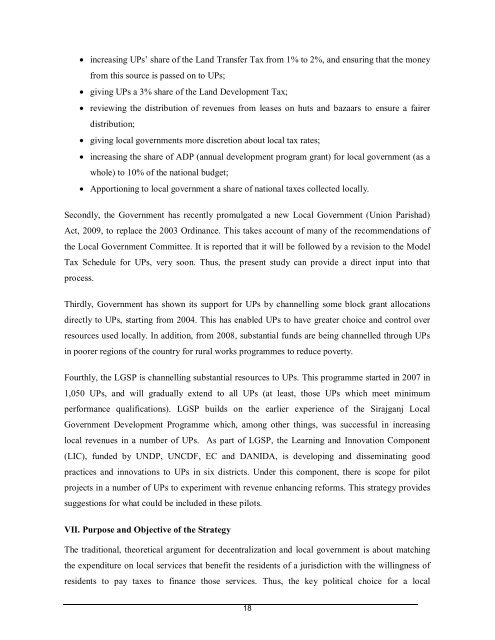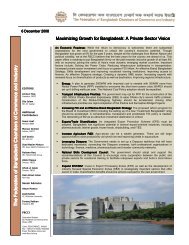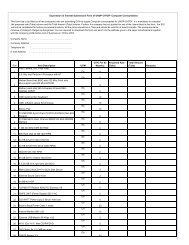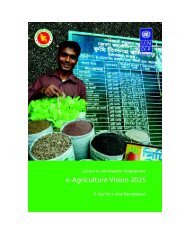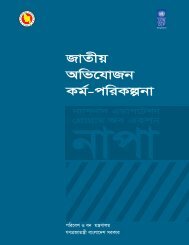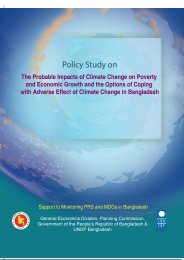Framework for a Strategy of UP Revenue/Resource Mobilisation ...
Framework for a Strategy of UP Revenue/Resource Mobilisation ...
Framework for a Strategy of UP Revenue/Resource Mobilisation ...
Create successful ePaper yourself
Turn your PDF publications into a flip-book with our unique Google optimized e-Paper software.
� increasing <strong>UP</strong>s’ share <strong>of</strong> the Land Transfer Tax from 1% to 2%, and ensuring that the money<br />
from this source is passed on to <strong>UP</strong>s;<br />
� giving <strong>UP</strong>s a 3% share <strong>of</strong> the Land Development Tax;<br />
� reviewing the distribution <strong>of</strong> revenues from leases on huts and bazaars to ensure a fairer<br />
distribution;<br />
� giving local governments more discretion about local tax rates;<br />
� increasing the share <strong>of</strong> ADP (annual development program grant) <strong>for</strong> local government (as a<br />
whole) to 10% <strong>of</strong> the national budget;<br />
� Apportioning to local government a share <strong>of</strong> national taxes collected locally.<br />
Secondly, the Government has recently promulgated a new Local Government (Union Parishad)<br />
Act, 2009, to replace the 2003 Ordinance. This takes account <strong>of</strong> many <strong>of</strong> the recommendations <strong>of</strong><br />
the Local Government Committee. It is reported that it will be followed by a revision to the Model<br />
Tax Schedule <strong>for</strong> <strong>UP</strong>s, very soon. Thus, the present study can provide a direct input into that<br />
process.<br />
Thirdly, Government has shown its support <strong>for</strong> <strong>UP</strong>s by channelling some block grant allocations<br />
directly to <strong>UP</strong>s, starting from 2004. This has enabled <strong>UP</strong>s to have greater choice and control over<br />
resources used locally. In addition, from 2008, substantial funds are being channelled through <strong>UP</strong>s<br />
in poorer regions <strong>of</strong> the country <strong>for</strong> rural works programmes to reduce poverty.<br />
Fourthly, the LGSP is channelling substantial resources to <strong>UP</strong>s. This programme started in 2007 in<br />
1,050 <strong>UP</strong>s, and will gradually extend to all <strong>UP</strong>s (at least, those <strong>UP</strong>s which meet minimum<br />
per<strong>for</strong>mance qualifications). LGSP builds on the earlier experience <strong>of</strong> the Sirajganj Local<br />
Government Development Programme which, among other things, was successful in increasing<br />
local revenues in a number <strong>of</strong> <strong>UP</strong>s. As part <strong>of</strong> LGSP, the Learning and Innovation Component<br />
(LIC), funded by UNDP, UNCDF, EC and DANIDA, is developing and disseminating good<br />
practices and innovations to <strong>UP</strong>s in six districts. Under this component, there is scope <strong>for</strong> pilot<br />
projects in a number <strong>of</strong> <strong>UP</strong>s to experiment with revenue enhancing re<strong>for</strong>ms. This strategy provides<br />
suggestions <strong>for</strong> what could be included in these pilots.<br />
VII. Purpose and Objective <strong>of</strong> the <strong>Strategy</strong><br />
The traditional, theoretical argument <strong>for</strong> decentralization and local government is about matching<br />
the expenditure on local services that benefit the residents <strong>of</strong> a jurisdiction with the willingness <strong>of</strong><br />
residents to pay taxes to finance those services. Thus, the key political choice <strong>for</strong> a local<br />
18


